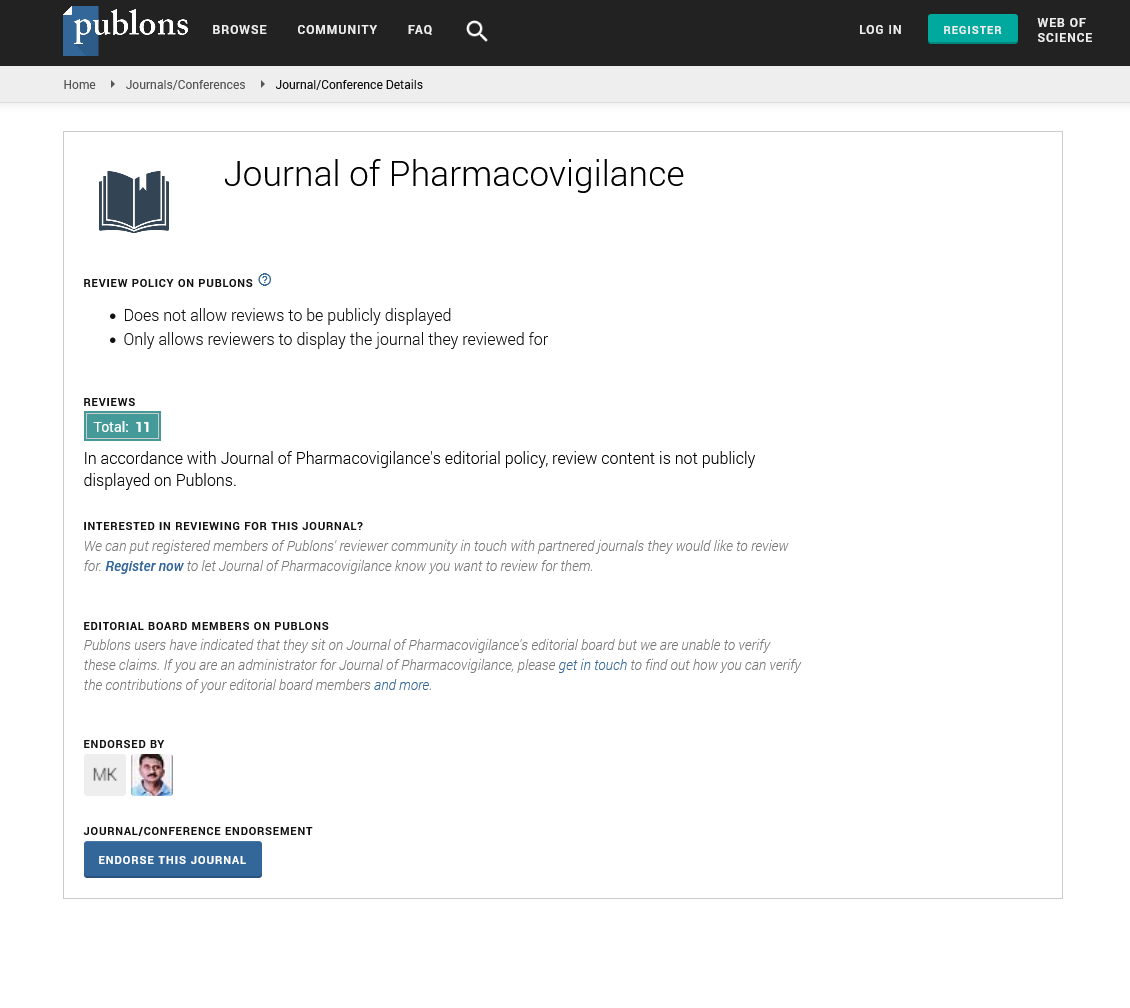Indexed In
- Open J Gate
- JournalTOCs
- The Global Impact Factor (GIF)
- RefSeek
- Hamdard University
- EBSCO A-Z
- OCLC- WorldCat
- Publons
- Euro Pub
- Google Scholar
Useful Links
Share This Page
Journal Flyer

Open Access Journals
- Agri and Aquaculture
- Biochemistry
- Bioinformatics & Systems Biology
- Business & Management
- Chemistry
- Clinical Sciences
- Engineering
- Food & Nutrition
- General Science
- Genetics & Molecular Biology
- Immunology & Microbiology
- Medical Sciences
- Neuroscience & Psychology
- Nursing & Health Care
- Pharmaceutical Sciences
Perspective - (2024) Volume 12, Issue 3
Enhancing Pharmacovigilance through Social Media for Drug Safety
Anya Petrova*Received: 28-Aug-2024, Manuscript No. JP-24-27182; Editor assigned: 30-Aug-2024, Pre QC No. JP-24-27182(PQ); Reviewed: 13-Sep-2024, QC No. JP-24-27182; Revised: 20-Sep-2024, Manuscript No. JP-24-27182(R); Published: 27-Sep-2024, DOI: 10.35248/2329-6887.24.12.493
Description
In the age of digital communication, social media has transformed the way we share and access information. Pharmacovigilance, the science of detecting, assessing and preventing adverse effects of pharmaceutical products, has traditionally relied on structured data from clinical trials, healthcare providers and regulatory agencies. However, the rise of social media has introduced a new, dynamic source of information that is reshaping the landscape of drug safety monitoring. Pharmacovigilance has been a vital part of public health, ensuring that the benefits of medications outweigh their risks. Social media, with its vast user base and real-time nature, offers a complementary approach to traditional pharmacovigilance methods. Social media platforms have become have become rich sources of information, where patients freely share their experiences with medications. This user-generated content can provide valuable insights into drug safety, uncovering adverse effects that might otherwise go unnoticed. Social media platforms enable real-time monitoring of patient experiences with medications. Unlike traditional reporting systems, which may take weeks or months to process Adverse Drug Reaction (ADR) reports, social media posts are immediate. This real-time aspect allows for quicker identification of potential safety issues, enabling faster responses from healthcare providers and regulatory agencies.
Social media reaches a diverse and vast audience, including individuals who might not engage with traditional healthcare systems. This broader reach increases the likelihood of capturing adverse effects from a wider population, including marginalized groups who may have limited access to healthcare. Social media posts often contain detailed descriptions of patients’ experiences, including symptoms, duration and impact on daily life. This qualitative data can provide context to ADRs, helping pharmacovigilance professionals better understand the severity and nature of adverse effects. Social media fosters greater patient engagement, empowering individuals to share their stories and connect with others experiencing similar issues. This sense of community can encourage more patients to report ADRs, contributing to a more comprehensive pharmacovigilance database. Social media data is unstructured and can vary in quality. Unlike traditional ADR reports, which are often verified by healthcare professionals, social media posts may contain incomplete or inaccurate information. Ensuring the reliability of this data is a critical challenge for pharmacovigilance. The use of social media data for pharmacovigilance raises privacy and ethical issues. Patients may not be aware that their posts are being monitored for drug safety purposes. Transparent communication and informed consent are essential to address these concerns and maintain public trust. The sheer volume of social media posts can be overwhelming, making it challenging to filter out relevant information from the noise. Advanced data mining and Natural Language Processing (NLP) techniques are needed to efficiently identify and analyze ADRs in social media content. The integration of social media into pharmacovigilance requires updates to regulatory frameworks.
Conclusion
Regulatory agencies must establish guidelines for the use of social media data, ensuring that it is used ethically and effectively to enhance drug safety. The U.S. Food and Drug Administration (FDA) has recognized the value of social media in pharmacovigilance. The MedWatch program has integrated social media monitoring to identify emerging safety signals. By analyzing social media data, the FDA can detect adverse effects earlier and take appropriate regulatory actions. The EMA has also explored the use of social media for pharmacovigilance. Through pilot projects, the agency has assessed the feasibility of using social media data to complement traditional ADR reporting systems. These efforts have highlighted the potential for social media to provide additional safety information and improve patient outcomes. Pharmaceutical companies are increasingly leveraging social media to enhance pharmacovigilance. By monitoring social media platforms, companies can identify adverse effects, gauge patient sentiment and proactively address safety concerns.
Citation: Evans R (2024). Enhancing Pharmacovigilance through Social Media for Drug Safety. J Pharmacovigil. 12:493.
Copyright: © 2024 Evans R. This is an open-access article distributed under the terms of the Creative Commons Attribution License, which permits unrestricted use, distribution, and reproduction in any medium, provided the original author and source are credited.

